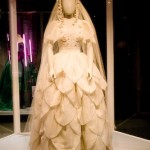I had a huge problem with the Victoria and Albert Museum. Maybe that’s not the most gracious of ways to begin a post but it’s the only way that seems fitting. I was really excited to go to the museum. Not only had I heard only rave reviews from my classmates but I had also been introduced to just a taste of all the many ways that Victoria and Albert aided the arts and science communities on our very first day here on our tube stop adventure. I was expecting a museum that displayed some of the finest collections of art-sy and science-sy things shown off in an almost magical way. What did the museum show me though? Wedding dresses. The only thing I remember from all of the exhibitions is the fashion room. Maybe that wasn’t the best room for a person like me to go into (I’m not the best at coordinating colors and prints but, in my defense, I at least know that plaid and stripes don’t go together). Still, I think that a person without the least bit of fashion sense should be able to go into an exhibit in this type of museum and not come out with a feeling of outrage. Now, I have been researching feminist literary figures in the Bloomsbury area for the past week so maybe I’m a bit more sensitive to gender issues than I might normally be. That being said, the fashion room was laid out in a way that seemed to make the statement that the epitome of female dress could be found in a wedding dress. I don’t know if I’m alone in this sentiment but that statement couldn’t be more belittling or insulting. In my mind, glorifying a wedding dress in this way fits into the mindset that women are to only aspire to be a wife. I have nothing against marriage and think that being a stay-at-home-mom is quite a respectable position in life. But to be limited to such a role is wrong and it is exactly that limitation that I feel the fashion room in this museum was advertising.
Women have for years been actively pursuing equal opportunities in the workplace and home alike. Many women from the London area made great strides in assuring these opportunities came about. In the literary world, Virginia Woolf, George Eliot, Vera Brittain, Jane Austen– these are just a few of the women who pushed their way to the forefront of the literary world and showed that women had as much talent as men and should be given the opportunity to showcase that talent. Other influential women such as Millicent Garrett Fawcett, Sylvia Pankhurst, and Nancy Astor also have an important influence in the city. Let’s not forget that some of the most memorable sovereigns of the nation were women. Queen Elizabeth I, Queen Elizabeth II, and even Queen Victoria herself made contributions to the well being of the nation that cannot be overlooked. Though incredibly diverse in their many accomplishments, all of these women have one thing in common: their lives amounted to more than a wedding dress.
The Victoria and Albert Museum seems to ignore the rich history of powerful females in London though and, instead, caters to the idea that the aspiration of women is to look good on their wedding day. I think this is most clearly demonstrated in the wedding dress by Neymar that was worn by Angela Stamp on their wedding day in 1976. It was designed to resemble something Anne Boleyn would have worn.

Angela Stam's Neymar wedding dress
Anne Boleyn used marriage as a social stepladder more than possibly any other woman in history in my opinion. Taking any connection to the dress’s primary influence away though, the dress itself showcases exactly what the feminist movement was rebelling against in the 1970s. It is embroidered with beads and flowers and covered in frills and folds is such a way that it emphasizes the dress not the woman. In fact, the mannequin on display has absolutely no facial attributes at all. The woman is literally unnecessary. To me this implies that any woman can be placed into this dress, it wouldn’t matter at all who is in it. The dress is going to serve its purpose. The dress is going to find the desired husband (the husband who wants his wife in such a dress and will pay to make sure she looks like this to her public). Yes, it is crafted beautifully and is truly a sight to see. Other dresses were just as beautiful though, but it was this dress along with two other wedding dresses that were on display in single cases. It was this dress along with two other wedding dresses that attracted everyone’s attention. The museum is compiling a collection of wedding dresses for their wedding dress exhibit in 2013. It’s currently 2009. These wedding dresses aren’t a part of that exhibit. These wedding dresses are a part of the everyday collection and as such send the message (at least to me) that these are important enough to be set aside from all the other dresses because they are the most important clothes that women can ever put on. I would argue that’s just simply not the case.
I’m not even going to get started on the significant lack of male clothes present in the exhibit. There was a case of suits in the entire room. That was it. I recognize that that inequality is also a problem but the message of limitation through the wedding dresses was what struck me most in the room. Again, I was excited about seeing the museum. Victoria and Albert made incredible contributions to the art and science communities that shouldn’t be ignored. Unfortunately, the way in which the wedding dresses were displayed made all of their accomplishments completely invisible to me. All I could see was lace and embroidery.
